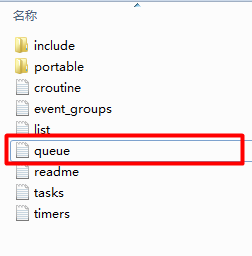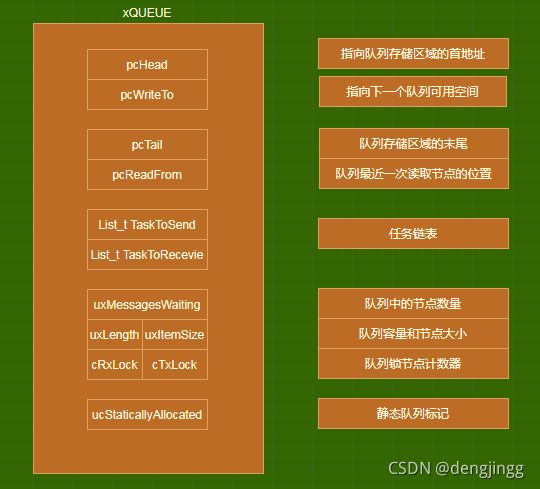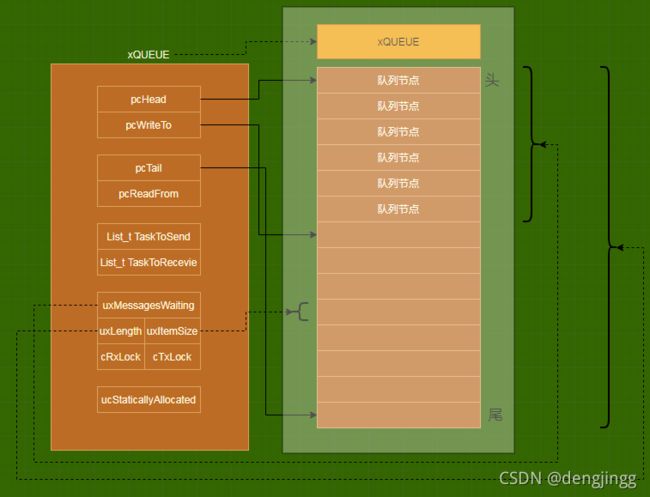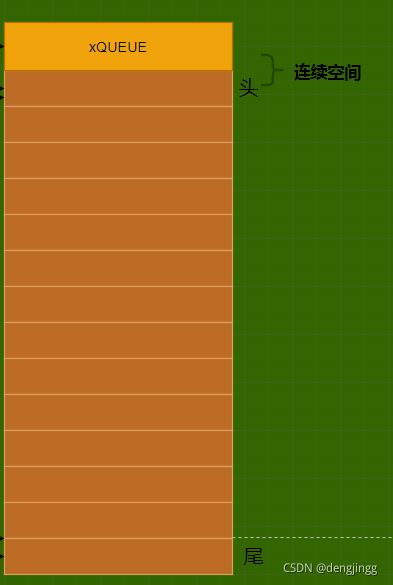Freertos 源码分析 队列queue
队列queue
(零) 队列的基础概念和形态
(一)Freertos 队列
queue.c
FreeRTOS-Kernel-10.4.6\include\queue.h

Freertos队列模块包含两个文件queue.c、 queue.h
queue.h 中列举了 队列的API和说明包括如何使用API的例子,可以说是非常详细了。
包含每个API的参数
如果仅仅是要使用队列,看h文档的说明已经足够
队列的创建
* Example usage:
* @code{c}
* struct AMessage
* {
* char ucMessageID;
* char ucData[ 20 ];
* };
* /*消息结构,用户可以自己定义想要的消息数据构成,一般包含ID用来区分消息,data是消息所带的数据*/
*
* void vATask( void *pvParameters )
* {
* QueueHandle_t xQueue1, xQueue2;
*
* // Create a queue capable of containing 10 uint32_t values.
* xQueue1 = xQueueCreate( 10, sizeof( uint32_t ) );
* if( xQueue1 == 0 )
* {
* // Queue was not created and must not be used.
* }
*
* // Create a queue capable of containing 10 pointers to AMessage structures.
* // These should be passed by pointer as they contain a lot of data.
* xQueue2 = xQueueCreate( 10, sizeof( struct AMessage * ) );
* if( xQueue2 == 0 )
* {
* // Queue was not created and must not be used.
* }
*
* // ... Rest of task code.
* }
注意Freertos可以动态和静态的创建队列,嵌入式系统追求稳定性建议不要使用动态队列。因为无论多先进的内存管理技术都会产生内存碎片 ,安全性高的场合禁止使用动态创建。
静态队列的创建略微麻烦一点
动态创建队列
#if ( configSUPPORT_DYNAMIC_ALLOCATION == 1 )
#define xQueueCreate( uxQueueLength, uxItemSize ) xQueueGenericCreate( ( uxQueueLength ), ( uxItemSize ), ( queueQUEUE_TYPE_BASE ) )
#endif
静态 创建队列
#if ( configSUPPORT_STATIC_ALLOCATION == 1 )
#define xQueueCreateStatic( uxQueueLength, uxItemSize, pucQueueStorage, pxQueueBuffer ) xQueueGenericCreateStatic( ( uxQueueLength ), ( uxItemSize ), ( pucQueueStorage ), ( pxQueueBuffer ), ( queueQUEUE_TYPE_BASE ) )
#endif /* configSUPPORT_STATIC_ALLOCATION */
静态队列的创建略微麻烦一点,需要指定缓存大小
Example usage:
* @code{c}
* struct AMessage
* {
* char ucMessageID;
* char ucData[ 20 ];
* };
*
#define QUEUE_LENGTH 10
#define ITEM_SIZE sizeof( uint32_t )
*
* // xQueueBuffer will hold the queue structure.
* StaticQueue_t xQueueBuffer;
*
* // ucQueueStorage will hold the items posted to the queue. Must be at least
* // [(queue length) * ( queue item size)] bytes long.
* uint8_t ucQueueStorage[ QUEUE_LENGTH * ITEM_SIZE ];
*
* void vATask( void *pvParameters )
* {
* QueueHandle_t xQueue1;
*
* // Create a queue capable of containing 10 uint32_t values.
* xQueue1 = xQueueCreate( QUEUE_LENGTH, // The number of items the queue can hold.
* ITEM_SIZE // The size of each item in the queue
* &( ucQueueStorage[ 0 ] ), // The buffer that will hold the items in the queue.
* &xQueueBuffer ); // The buffer that will hold the queue structure.
*
* // The queue is guaranteed to be created successfully as no dynamic memory
* // allocation is used. Therefore xQueue1 is now a handle to a valid queue.
*
* // ... Rest of task code.
* }
我们 查看上面的代码发现 StaticQueue_t 有这样一个结构体,其中的定义如下
看到代码有点蒙
typedef struct xSTATIC_QUEUE
{
void *pvDummy1[ 3 ];
union
{
void *pvDummy2;
UBaseType_t uxDummy2;
} u;
StaticList_t xDummy3[ 2 ];
UBaseType_t uxDummy4[ 3 ];
uint8_t ucDummy5[ 2 ];
#if( ( configSUPPORT_STATIC_ALLOCATION == 1 ) && ( configSUPPORT_DYNAMIC_ALLOCATION == 1 ) )
uint8_t ucDummy6;
#endif
#if ( configUSE_QUEUE_SETS == 1 )
void *pvDummy7;
#endif
#if ( configUSE_TRACE_FACILITY == 1 )
UBaseType_t uxDummy8;
uint8_t ucDummy9;
#endif
} StaticQueue_t;
很多Dummy的变量让人意识摸不着头脑。
/*
* In line with software engineering best practice, FreeRTOS implements a strict
* data hiding policy, so the real structures used by FreeRTOS to maintain the
* state of tasks, queues, semaphores, etc. are not accessible to the application
* code. However, if the application writer wants to statically allocate such
* an object then the size of the object needs to be known. Dummy structures
* that are guaranteed to have the same size and alignment requirements of the
* real objects are used for this purpose. The dummy list and list item
* structures below are used for inclusion in such a dummy structure.
*/
意识就是要预留出空间,让使用Freertos的用户可以知道内部数据的 大小,然而看完这段话,并没有什么用。其实上面的结构体定义是队列数据类型的定义
仔细对比一下这两块代码,发现是一样的。
queue.c
typedef struct QueueDefinition /* The old naming convention is used to prevent breaking kernel aware debuggers. */
{
int8_t * pcHead; /*< Points to the beginning of the queue storage area. */
int8_t * pcWriteTo; /*< Points to the free next place in the storage area. */
union
{
QueuePointers_t xQueue; /*< Data required exclusively when this structure is used as a queue. */
SemaphoreData_t xSemaphore; /*< Data required exclusively when this structure is used as a semaphore. */
} u;
List_t xTasksWaitingToSend; /*< List of tasks that are blocked waiting to post onto this queue. Stored in priority order. */
List_t xTasksWaitingToReceive; /*< List of tasks that are blocked waiting to read from this queue. Stored in priority order. */
volatile UBaseType_t uxMessagesWaiting; /*< The number of items currently in the queue. */
UBaseType_t uxLength; /*< The length of the queue defined as the number of items it will hold, not the number of bytes. */
UBaseType_t uxItemSize; /*< The size of each items that the queue will hold. */
volatile int8_t cRxLock; /*< Stores the number of items received from the queue (removed from the queue) while the queue was locked. Set to queueUNLOCKED when the queue is not locked. */
volatile int8_t cTxLock; /*< Stores the number of items transmitted to the queue (added to the queue) while the queue was locked. Set to queueUNLOCKED when the queue is not locked. */
#if ( ( configSUPPORT_STATIC_ALLOCATION == 1 ) && ( configSUPPORT_DYNAMIC_ALLOCATION == 1 ) )
uint8_t ucStaticallyAllocated; /*< Set to pdTRUE if the memory used by the queue was statically allocated to ensure no attempt is made to free the memory. */
#endif
#if ( configUSE_QUEUE_SETS == 1 )
struct QueueDefinition * pxQueueSetContainer;
#endif
#if ( configUSE_TRACE_FACILITY == 1 )
UBaseType_t uxQueueNumber;
uint8_t ucQueueType;
#endif
} xQUEUE;
队列的结构图

基础队列一般包含 头、尾、节点的信息
Freertos队列所包含信息相当丰富
队列的静态创建
#if ( configSUPPORT_STATIC_ALLOCATION == 1 )
QueueHandle_t xQueueGenericCreateStatic( const UBaseType_t uxQueueLength,
const UBaseType_t uxItemSize,
uint8_t * pucQueueStorage,
StaticQueue_t * pxStaticQueue,
const uint8_t ucQueueType )
{
Queue_t * pxNewQueue = NULL;
/* The StaticQueue_t structure and the queue storage area must be
* supplied. */
configASSERT( pxStaticQueue );
if( ( uxQueueLength > ( UBaseType_t ) 0 ) &&
( pxStaticQueue != NULL ) &&
/* A queue storage area should be provided if the item size is not 0, and
* should not be provided if the item size is 0. */
( !( ( pucQueueStorage != NULL ) && ( uxItemSize == 0 ) ) ) &&
( !( ( pucQueueStorage == NULL ) && ( uxItemSize != 0 ) ) ) )
{
#if ( configASSERT_DEFINED == 1 )
{
/* Sanity check that the size of the structure used to declare a
* variable of type StaticQueue_t or StaticSemaphore_t equals the size of
* the real queue and semaphore structures. */
volatile size_t xSize = sizeof( StaticQueue_t );
/* This assertion cannot be branch covered in unit tests */
configASSERT( xSize == sizeof( Queue_t ) ); /* LCOV_EXCL_BR_LINE */
( void ) xSize; /* Keeps lint quiet when configASSERT() is not defined. */
}
#endif /* configASSERT_DEFINED */
/* The address of a statically allocated queue was passed in, use it.
* The address of a statically allocated storage area was also passed in
* but is already set. */
pxNewQueue = ( Queue_t * ) pxStaticQueue; /*lint !e740 !e9087 Unusual cast is ok as the structures are designed to have the same alignment, and the size is checked by an assert. */
#if ( configSUPPORT_DYNAMIC_ALLOCATION == 1 )
{
/* Queues can be allocated wither statically or dynamically, so
* note this queue was allocated statically in case the queue is
* later deleted. */
pxNewQueue->ucStaticallyAllocated = pdTRUE;
}
#endif /* configSUPPORT_DYNAMIC_ALLOCATION */
prvInitialiseNewQueue( uxQueueLength, uxItemSize, pucQueueStorage, ucQueueType, pxNewQueue );
}
else
{
configASSERT( pxNewQueue );
mtCOVERAGE_TEST_MARKER();
}
return pxNewQueue;
}
#endif /* configSUPPORT_STATIC_ALLOCATION */
创建 队列需要使用两块内存空间
空间1.队列控制块的空间 QueueDefinition /xQueue 用来代表队列抽象
空间2.队列节点的存储空间,每次增加/删除节点都在在这个空间内操作
空间1 的大小由Freertos 定义,大小固定
空间2 的大小由开发人员指定,可以动态的创建。所以可能会遇到剩余空间大小的问题,动态创建的时 候这个问题会标的更加复杂
队列所占空间

队列创建后的初始化
static void prvInitialiseNewQueue( const UBaseType_t uxQueueLength,
const UBaseType_t uxItemSize,
uint8_t * pucQueueStorage,
const uint8_t ucQueueType,
Queue_t * pxNewQueue )
{
/* Remove compiler warnings about unused parameters should
* configUSE_TRACE_FACILITY not be set to 1. */
( void ) ucQueueType;
if( uxItemSize == ( UBaseType_t ) 0 )
{
/* No RAM was allocated for the queue storage area, but PC head cannot
* be set to NULL because NULL is used as a key to say the queue is used as
* a mutex. Therefore just set pcHead to point to the queue as a benign
* value that is known to be within the memory map. */
pxNewQueue->pcHead = ( int8_t * ) pxNewQueue;
}
else
{
/* Set the head to the start of the queue storage area. */
pxNewQueue->pcHead = ( int8_t * ) pucQueueStorage;
}
/* Initialise the queue members as described where the queue type is
* defined. */
pxNewQueue->uxLength = uxQueueLength;
pxNewQueue->uxItemSize = uxItemSize;
( void ) xQueueGenericReset( pxNewQueue, pdTRUE );
#if ( configUSE_TRACE_FACILITY == 1 )
{
pxNewQueue->ucQueueType = ucQueueType;
}
#endif /* configUSE_TRACE_FACILITY */
#if ( configUSE_QUEUE_SETS == 1 )
{
pxNewQueue->pxQueueSetContainer = NULL;
}
#endif /* configUSE_QUEUE_SETS */
traceQUEUE_CREATE( pxNewQueue );
}
QueueHandle_t xQueueGenericCreateStatic( const UBaseType_t uxQueueLength,
const UBaseType_t uxItemSize,
uint8_t * pucQueueStorage,
StaticQueue_t * pxStaticQueue,
const uint8_t ucQueueType )
uxQueueLength 也就是上图头尾之间有多少个格子,就是最大能包含多少节点(或者称为Item)
uxItemSize 就是上图 uxItemSize 代表一个节点所需要的空间,Freertos把数据拷贝到节点中,相当于在节点中复制了一个副本
pucQueueStorage 头尾直接所占用的空间大小
pxStaticQueue xQUEUE
ucQueueType 如下所示,队列结构可以有多种结构 我们暂时关注queueQUEUE_TYPE_BASE
#define queueQUEUE_TYPE_BASE ( ( uint8_t ) 0U )
#define queueQUEUE_TYPE_SET ( ( uint8_t ) 0U )
#define queueQUEUE_TYPE_MUTEX ( ( uint8_t ) 1U )
#define queueQUEUE_TYPE_COUNTING_SEMAPHORE ( ( uint8_t ) 2U )
#define queueQUEUE_TYPE_BINARY_SEMAPHORE ( ( uint8_t ) 3U )
#define queueQUEUE_TYPE_RECURSIVE_MUTEX ( ( uint8_t ) 4U )
其实这个时候不看代码的情况下,我们应该知道如何初始化一个队列
队列结构体中的变量该如何装填的问题

BaseType_t xQueueGenericReset( QueueHandle_t xQueue,
BaseType_t xNewQueue )
{
BaseType_t xReturn = pdPASS;
Queue_t * const pxQueue = xQueue;
configASSERT( pxQueue );
if( ( pxQueue != NULL ) &&
( pxQueue->uxLength >= 1U ) &&
/* Check for multiplication overflow. */
( ( SIZE_MAX / pxQueue->uxLength ) >= pxQueue->uxItemSize ) )
{
taskENTER_CRITICAL();
{
pxQueue->u.xQueue.pcTail = pxQueue->pcHead + ( pxQueue->uxLength * pxQueue->uxItemSize ); /*lint !e9016 Pointer arithmetic allowed on char types, especially when it assists conveying intent. */
pxQueue->uxMessagesWaiting = ( UBaseType_t ) 0U;
pxQueue->pcWriteTo = pxQueue->pcHead;
pxQueue->u.xQueue.pcReadFrom = pxQueue->pcHead + ( ( pxQueue->uxLength - 1U ) * pxQueue->uxItemSize ); /*lint !e9016 Pointer arithmetic allowed on char types, especially when it assists conveying intent. */
pxQueue->cRxLock = queueUNLOCKED;
pxQueue->cTxLock = queueUNLOCKED;
if( xNewQueue == pdFALSE )
{
/* If there are tasks blocked waiting to read from the queue, then
* the tasks will remain blocked as after this function exits the queue
* will still be empty. If there are tasks blocked waiting to write to
* the queue, then one should be unblocked as after this function exits
* it will be possible to write to it. */
if( listLIST_IS_EMPTY( &( pxQueue->xTasksWaitingToSend ) ) == pdFALSE )
{
if( xTaskRemoveFromEventList( &( pxQueue->xTasksWaitingToSend ) ) != pdFALSE )
{
queueYIELD_IF_USING_PREEMPTION();
}
else
{
mtCOVERAGE_TEST_MARKER();
}
}
else
{
mtCOVERAGE_TEST_MARKER();
}
}
else
{
/* Ensure the event queues start in the correct state. */
vListInitialise( &( pxQueue->xTasksWaitingToSend ) );
vListInitialise( &( pxQueue->xTasksWaitingToReceive ) );
}
}
taskEXIT_CRITICAL();
}
else
{
xReturn = pdFAIL;
}
configASSERT( xReturn != pdFAIL );
/* A value is returned for calling semantic consistency with previous
* versions. */
return xReturn;
}
reset函数不仅仅在初始化的时候使用。所以这里还考虑到了其他的情况。当写队列的任务被阻塞,又需要reset队列,如果reset执行完成后阻塞的任务执行写队列,这个时候reset动作看上去出了BUG,简单说就是怎么没清理干净,还有余孽。从而有了下面这段代码
if( listLIST_IS_EMPTY( &( pxQueue->xTasksWaitingToSend ) ) == pdFALSE )
{
if( xTaskRemoveFromEventList( &( pxQueue->xTasksWaitingToSend ) ) != pdFALSE )
{
queueYIELD_IF_USING_PREEMPTION();
}
else
{
mtCOVERAGE_TEST_MARKER();
}
}
动态队列创建
与静态队列相比较,动态队列使用到了Malloc,在程序运行时创建队列的空间。

动态创建和静态创建队列除了在内存上的差异其他地方基本相同。
动态创建出的是连续空间,队列xQUEUE和队列空间是连续的空间。
QueueHandle_t xQueueGenericCreate( const UBaseType_t uxQueueLength,
const UBaseType_t uxItemSize,
const uint8_t ucQueueType )
{
Queue_t * pxNewQueue = NULL;
size_t xQueueSizeInBytes;
uint8_t * pucQueueStorage;
if( ( uxQueueLength > ( UBaseType_t ) 0 ) &&
/* Check for multiplication overflow. */
( ( SIZE_MAX / uxQueueLength ) >= uxItemSize ) &&
/* Check for addition overflow. */
( ( SIZE_MAX - sizeof( Queue_t ) ) >= ( uxQueueLength * uxItemSize ) ) )
{
/* Allocate enough space to hold the maximum number of items that
* can be in the queue at any time. It is valid for uxItemSize to be
* zero in the case the queue is used as a semaphore. */
xQueueSizeInBytes = ( size_t ) ( uxQueueLength * uxItemSize ); /*lint !e961 MISRA exception as the casts are only redundant for some ports. */
/* Allocate the queue and storage area. Justification for MISRA
* deviation as follows: pvPortMalloc() always ensures returned memory
* blocks are aligned per the requirements of the MCU stack. In this case
* pvPortMalloc() must return a pointer that is guaranteed to meet the
* alignment requirements of the Queue_t structure - which in this case
* is an int8_t *. Therefore, whenever the stack alignment requirements
* are greater than or equal to the pointer to char requirements the cast
* is safe. In other cases alignment requirements are not strict (one or
* two bytes). */
pxNewQueue = ( Queue_t * ) pvPortMalloc( sizeof( Queue_t ) + xQueueSizeInBytes ); /*lint !e9087 !e9079 see comment above. */
if( pxNewQueue != NULL )
{
/* Jump past the queue structure to find the location of the queue
* storage area. */
pucQueueStorage = ( uint8_t * ) pxNewQueue;
pucQueueStorage += sizeof( Queue_t ); /*lint !e9016 Pointer arithmetic allowed on char types, especially when it assists conveying intent. */
#if ( configSUPPORT_STATIC_ALLOCATION == 1 )
{
/* Queues can be created either statically or dynamically, so
* note this task was created dynamically in case it is later
* deleted. */
pxNewQueue->ucStaticallyAllocated = pdFALSE;
}
#endif /* configSUPPORT_STATIC_ALLOCATION */
prvInitialiseNewQueue( uxQueueLength, uxItemSize, pucQueueStorage, ucQueueType, pxNewQueue );
}
else
{
traceQUEUE_CREATE_FAILED( ucQueueType );
mtCOVERAGE_TEST_MARKER();
}
}
else
{
configASSERT( pxNewQueue );
mtCOVERAGE_TEST_MARKER();
}
return pxNewQueue;
}
队列的创建,初始化就到这里
队列的发送(入队、入栈)
先来看一段代码
* Example usage:
* @code{c}
* struct AMessage
* {
* char ucMessageID;
* char ucData[ 20 ];
* } xMessage;
*
* uint32_t ulVar = 10UL;
*
* void vATask( void *pvParameters )
* {
* QueueHandle_t xQueue1, xQueue2;
* struct AMessage *pxMessage;
*
* // Create a queue capable of containing 10 uint32_t values.
* xQueue1 = xQueueCreate( 10, sizeof( uint32_t ) );
*
* // Create a queue capable of containing 10 pointers to AMessage structures.
* // These should be passed by pointer as they contain a lot of data.
* xQueue2 = xQueueCreate( 10, sizeof( struct AMessage * ) );
*
* // ...
*
* if( xQueue1 != 0 )
* {
* // Send an uint32_t. Wait for 10 ticks for space to become
* // available if necessary.
* if( xQueueSendToFront( xQueue1, ( void * ) &ulVar, ( TickType_t ) 10 ) != pdPASS )
* {
* // Failed to post the message, even after 10 ticks.
* }
* }
*
* if( xQueue2 != 0 )
* {
* // Send a pointer to a struct AMessage object. Don't block if the
* // queue is already full.
* pxMessage = & xMessage;
* xQueueSendToFront( xQueue2, ( void * ) &pxMessage, ( TickType_t ) 0 );
* }
*
* // ... Rest of task code.
* }
* @endcode
* \defgroup xQueueSend xQueueSend
* \ingroup QueueManagement
xQueue1 队列节点是uint32类型 xQueue2是用户自己定义的结构体类型
传入参数非常明了
1.队列实体
2.节点
3.阻塞时间(等待时间)
xQueueGenericSend 代码段过长。所以把xQueueGenericSend中重要的函数理解透了,也就清楚的知道队列是如何进行发送的。prvCopyDataToQueue 是重点函数
static BaseType_t prvCopyDataToQueue( Queue_t * const pxQueue,
const void * pvItemToQueue,
const BaseType_t xPosition )
{
BaseType_t xReturn = pdFALSE;
UBaseType_t uxMessagesWaiting;
/* This function is called from a critical section. */
uxMessagesWaiting = pxQueue->uxMessagesWaiting;
if( pxQueue->uxItemSize == ( UBaseType_t ) 0 )
{
#if ( configUSE_MUTEXES == 1 )
{
if( pxQueue->uxQueueType == queueQUEUE_IS_MUTEX )
{
/* The mutex is no longer being held. */
xReturn = xTaskPriorityDisinherit( pxQueue->u.xSemaphore.xMutexHolder );
pxQueue->u.xSemaphore.xMutexHolder = NULL;
}
else
{
mtCOVERAGE_TEST_MARKER();
}
}
#endif /* configUSE_MUTEXES */
}
else if( xPosition == queueSEND_TO_BACK )
{
( void ) memcpy( ( void * ) pxQueue->pcWriteTo, pvItemToQueue, ( size_t ) pxQueue->uxItemSize ); /*lint !e961 !e418 !e9087 MISRA exception as the casts are only redundant for some ports, plus previous logic ensures a null pointer can only be passed to memcpy() if the copy size is 0. Cast to void required by function signature and safe as no alignment requirement and copy length specified in bytes. */
pxQueue->pcWriteTo += pxQueue->uxItemSize; /*lint !e9016 Pointer arithmetic on char types ok, especially in this use case where it is the clearest way of conveying intent. */
if( pxQueue->pcWriteTo >= pxQueue->u.xQueue.pcTail ) /*lint !e946 MISRA exception justified as comparison of pointers is the cleanest solution. */
{
pxQueue->pcWriteTo = pxQueue->pcHead;
}
else
{
mtCOVERAGE_TEST_MARKER();
}
}
else
{
( void ) memcpy( ( void * ) pxQueue->u.xQueue.pcReadFrom, pvItemToQueue, ( size_t ) pxQueue->uxItemSize ); /*lint !e961 !e9087 !e418 MISRA exception as the casts are only redundant for some ports. Cast to void required by function signature and safe as no alignment requirement and copy length specified in bytes. Assert checks null pointer only used when length is 0. */
pxQueue->u.xQueue.pcReadFrom -= pxQueue->uxItemSize;
if( pxQueue->u.xQueue.pcReadFrom < pxQueue->pcHead ) /*lint !e946 MISRA exception justified as comparison of pointers is the cleanest solution. */
{
pxQueue->u.xQueue.pcReadFrom = ( pxQueue->u.xQueue.pcTail - pxQueue->uxItemSize );
}
else
{
mtCOVERAGE_TEST_MARKER();
}
if( xPosition == queueOVERWRITE )
{
if( uxMessagesWaiting > ( UBaseType_t ) 0 )
{
/* An item is not being added but overwritten, so subtract
* one from the recorded number of items in the queue so when
* one is added again below the number of recorded items remains
* correct. */
--uxMessagesWaiting;
}
else
{
mtCOVERAGE_TEST_MARKER();
}
}
else
{
mtCOVERAGE_TEST_MARKER();
}
}
pxQueue->uxMessagesWaiting = uxMessagesWaiting + ( UBaseType_t ) 1;
return xReturn;
}
配合这幅图,阅读上面的代码应该没有问题。
后面的操作会涉及到TASK,等到任务章节分享。
当队列中的消息是空时,读取消息的任务将被阻塞,用户还可
以指定阻塞的任务时间 xTicksToWait,在这段时间中,如果队列为空,该任务将保持阻塞
状态以等待队列数据有效。 当队列中有新消息时, 被阻塞的任务会被唤醒并处理新消息。
/* If there was a task waiting for data to arrive on the
* queue then unblock it now. */
if( listLIST_IS_EMPTY( &( pxQueue->xTasksWaitingToReceive ) ) == pdFALSE )
{
if( xTaskRemoveFromEventList( &( pxQueue->xTasksWaitingToReceive ) ) != pdFALSE )
{
/* The unblocked task has a priority higher than
* our own so yield immediately. Yes it is ok to
* do this from within the critical section - the
* kernel takes care of that. */
queueYIELD_IF_USING_PREEMPTION();
}
else
{
mtCOVERAGE_TEST_MARKER();
}
}
else if( xYieldRequired != pdFALSE )
{
/* This path is a special case that will only get
* executed if the task was holding multiple mutexes
* and the mutexes were given back in an order that is
* different to that in which they were taken. */
queueYIELD_IF_USING_PREEMPTION();
}
else
{
mtCOVERAGE_TEST_MARKER();
}
队列的读取/接收
peak 就是偷看一眼不拿东西。队列里面的节点不会被删除,因为我们只是偷看一眼。
BaseType_t xQueuePeek( QueueHandle_t xQueue,
void * const pvBuffer,
TickType_t xTicksToWait )
函数中重点部分如下
static void prvCopyDataFromQueue( Queue_t * const pxQueue,
void * const pvBuffer )
{
if( pxQueue->uxItemSize != ( UBaseType_t ) 0 )
{
pxQueue->u.xQueue.pcReadFrom += pxQueue->uxItemSize; /*lint !e9016 Pointer arithmetic on char types ok, especially in this use case where it is the clearest way of conveying intent. */
if( pxQueue->u.xQueue.pcReadFrom >= pxQueue->u.xQueue.pcTail ) /*lint !e946 MISRA exception justified as use of the relational operator is the cleanest solutions. */
{
pxQueue->u.xQueue.pcReadFrom = pxQueue->pcHead;
}
else
{
mtCOVERAGE_TEST_MARKER();
}
( void ) memcpy( ( void * ) pvBuffer, ( void * ) pxQueue->u.xQueue.pcReadFrom, ( size_t ) pxQueue->uxItemSize ); /*lint !e961 !e418 !e9087 MISRA exception as the casts are only redundant for some ports. Also previous logic ensures a null pointer can only be passed to memcpy() when the count is 0. Cast to void required by function signature and safe as no alignment requirement and copy length specified in bytes. */
}
}
先把pcReadFrom 向下移动一格,如果超过了队列尾部,就移动到头部。显然Freertos的队列是循环队列。所以队列在逻辑上应该是一个饼状图。
pcReadFrom 也就提供了操作指正,接着把数据copy出来。
紧接着
/* The data is not being removed, so reset the read pointer. */
pxQueue->u.xQueue.pcReadFrom = pcOriginalReadPosition;
这句话就是peak不删除的作用应为pcReadFrom 没有移动。所以列表里面不会进行删除动作,只是移动了读取指针。直到数据被覆盖或者删除列表,原有的数据才会消失。
显然 xQueueReceive 不仅仅是看一下,看完就拿走。对比peak 就是下面几条语句不一样。
/* Data available, remove one item. */
prvCopyDataFromQueue( pxQueue, pvBuffer );
traceQUEUE_RECEIVE( pxQueue );
pxQueue->uxMessagesWaiting = uxMessagesWaiting - ( UBaseType_t ) 1;
